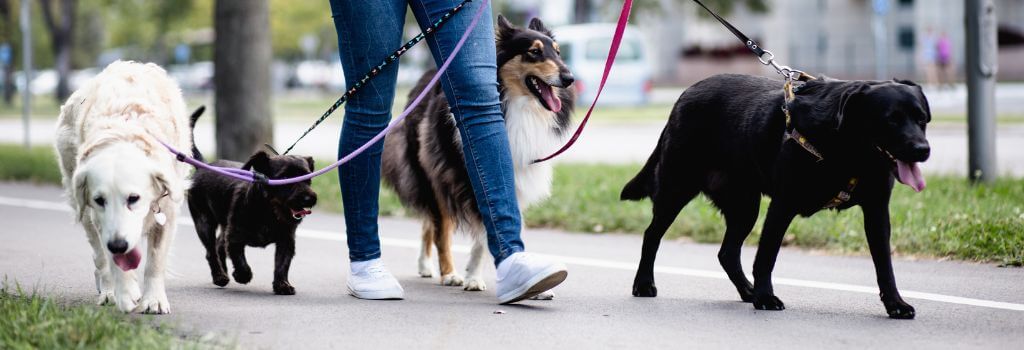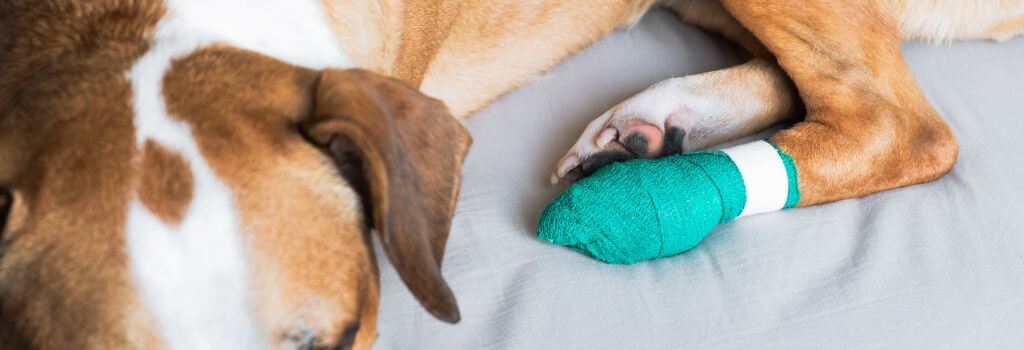When the weather heats up, many people are excited to spend more time outside with their dogs, running, hiking, walking around the neighborhood, or playing by the water. While all of these activities can be great for your dog’s physical and mental health, warm-weather outings can also come with hidden risks that many dog owners might not even think of, like paw pad burns. Sidewalks, asphalt, sand, and even boat docks or metal grates can become dangerously hot in the summer sun, putting your dog’s paw pads at risk of serious burns and injury.
But don’t let that information make you cancel your summer plans. These types of paw pad injuries are totally preventable with a little advanced planning and information on how paw pad burns happen.
What Are Dog Paw Pads?
Before we dive into the dangers that hot surfaces cause for dogs, it’s important to understand the anatomy of their paws and how the paws can be affected by the elements.
Let’s start by talking about paw pads. Dog paw pads are thick, cushiony pads of skin that cover the bottoms of a dog’s feet. They are made up of skin, fat, and connective tissue, helping dogs maintain proper balance and grip onto different surfaces or terrain. Paw pads also serve as natural shock absorbers, protecting a dog’s bones and joints while also cushioning their steps.
Though the skin of a dog’s paw pad may seem rough and thick, they can actually be quite sensitive if the conditions are right. Because a dog’s paw pads are packed with nerve endings, they can be sensitive to temperature, texture, and pain, making paw injuries a reality in extreme heat or cold or rough terrain. The thickness of a dog’s paw pads, as well as how sensitive they are, can vary from dog to dog and can be impacted by factors like how much time they spend outside, what types of terrain they walk on, and what type of activities they engage in.
How Paw Pad Burns Happen
Dogs will typically sustain burns to their paw pads after walking across hot surfaces that have absorbed and retained excessive heat. Dogs don’t wear shoes after all, and are essentially always barefoot, leaving their feet exposed to the elements. Asphalt, concrete, metal, and sand are the surfaces most known for causing paw pad burns, as they can be much hotter than the air temperature and may reach temperatures that can cause burns in less than a minute in the summer months. Even simple actions like stepping out of a car into a parking lot in direct sunlight or running across hot sand at the lake or beach can result in damage to a dog’s paws.
The actual process of how a paw pad burn occurs is similar to the manner in which humans sustain burns to their skin. While exceptionally protective, the thick outer skin of a dog’s paw pad can only withstand temperatures up to a certain degree. When a surface’s temperature exceeds 125°F, this outer layer can be compromised and damaged in under 60 seconds, leaving the rest of the foot’s structure and tissues vulnerable to further damage.

Puppies, senior dogs, and dogs with underlying health issues may be even more at risk because their paw pads may be more delicate or slower to heal, so it’s important for owners to always take the heat and ground temperature into consideration when taking their dog outside in warmer weather.
Signs of a Paw Pad Burn
The signs of a paw pad burn can vary from subtle to incredibly noticeable depending on the severity of the injury. The most commonly seen signs of a paw pad burn include:
- Limping or reluctance to walk, especially on hot or rough surfaces
- Frequent licking or chewing at the paws
- Redness or swelling of the paw pads
- Blisters or peeling skin on the pads
- Raw or open wounds in more severe cases
- Crying out or pulling away when the paws are touched
- General signs of discomfort or pain related to the feet
Assessing Mild vs. Severe Paw Pad Burns
The treatment needed for a burnt dog paw will depend on the severity of the burn. Paw pad burns can range from mild to severe, with each degree of burn having its own hallmarks and indicators.
- Mild burns may cause slight limping, hesitation to walk on certain surfaces, or occasional paw licking.
- Moderate to severe burns may cause your dog to refuse to walk altogether, show obvious pain, cry out when the paw is touched, or obsessively lick and chew at the area.
In order to determine the severity of a dog’s paw pad burn, you should begin by visually inspecting each of the dog’s individual paw pads. Look for any discoloration, swelling, or evidence of blisters, peeling, or open wounds. These visible traits can help determine the extent to which the paw pad has been injured.
- Redness or slight inflammation can commonly indicate a first-degree (mild) burn.
- Blisters or peeling skin may suggest a moderate second-degree burn.
- Open wounds, raw tissue, or missing pieces of the pad are signs of third-degree (severe) burns that require urgent medical care.
If all four paws are not affected, it can be helpful to compare injured vs. non-injured paws for visible differences and variances in temperature. Paw pads affected by burns may be warm to the touch, swollen, or noticeably more inflamed than the others, meaning that proper care and cleaning are needed ASAP.
Some mild burns may be able to be treated and managed at home, but any burn that falls into the moderate or severe categories will need immediate veterinary attention. If you’re ever in doubt about the extent of your injuries, get in contact with your veterinarian right away. They’ll be able to assess the injury and give you guidance on whether or not at-home treatment is appropriate, as well as some peace of mind.
How to Treat a Dog’s Burnt Paw Pads
If your dog is suffering from a burnt paw pad or you suspect that they’ve just stepped onto a surface that is too hot, the first thing you should do is remove them from the area and get them somewhere cool and shaded. From there, you can gently flush the affected paw or paws with cool water to help further reduce their current temperature and avoid additional damage. Be sure not to use cold water or ice on burnt paw pads, as the cold temperature can cause the blood vessels within the paw to quickly constrict, reducing blood flow to the area and potentially causing additional damage to the tissues within the paw. If you don’t have cool water on hand, a cool compress is another viable option for helping to cool your dog’s paws down.
Once the area is cool and clean, follow the steps we outlined above to assess the damage and extent of the burn, which will help you determine what type of treatment your dog will need.

Treating Paw Burns at Home
If your dog’s paw pad burn is mild, you can do the following things to take care of the burn at home and help your dog have a smooth recovery:
- Apply a soothing paw balm or ointment specifically designed for dogs to help moisturize and protect the skin. Do not use ointment, lotions, or antiseptics intended for human use, as these may have ingredients that impede healing or have adverse effects when used on dogs. If you have questions on what is best to use or want recommendations for specific products, reach out to your veterinarian; they should be happy to help! Keep the paw clean and dry between treatments, and reapply balm or ointment as directed.
- Prevent licking or chewing by using an e-collar cone or covering the paw with a breathable, non-stick bandage. Your dog may be tempted to chew at or remove the bandage, so e-collars and bandages may need to be used in tandem to allow the burn to heal uninterrupted.
- Limit activity to give the paw time to heal. During the recovery period, avoid walks, rough surfaces, or hot ground. Having your dog walk on the injured paw too much or exposing it to extreme heat again too soon could erase all of the healing progress that has been made, and in some cases, even worsen the condition of the burn.
- Monitor for signs of infection, such as increased redness, swelling, discharge, or odor. If you notice any of these signs, contact your veterinarian right away. Catching infections early is essential for saving your dog from further pain and damage to their paw.
How Your Veterinarian Will Treat Moderate to Severe Burns
For moderate or severe burns, professional veterinary treatment will absolutely be needed to reduce the risk of infection and ensure proper healing.
Treatment for paw pad burns typically starts with cleaning of the affected area to remove debris and bacteria. In some cases, your vet may perform debridement — removal of dead or damaged tissue — to help promote healing.
Once the area is thoroughly cleaned, the paw is usually bandaged using sterile, non-stick dressings. Similar to our recommendations for at-home burn care, your vet may recommend a protective bootie or wrap, and an e-collar to prevent your dog from licking or chewing their bandages or injured paw.
Burns can be incredibly painful for dogs, so your veterinarian will likely create a pain management plan to keep them comfortable while they recover. In addition to anti-inflammatory or pain-relief medications, your dog may also be prescribed antibiotics to fight or prevent infection, if they are deemed at risk.
Other Paw Pad Injuries to Be on the Lookout for Year Round
Burns and blisters aren’t the only type of injuries that dogs can sustain on their paw pads. Cuts, scrapes, and lacerations are common paw injuries that dogs can sustain any time of year and even indoors. Cuts and laceration injuries are typically sustained from a dog stepping on a sharp object, like broken glass, rocks, or thorns. They result in slices or open wounds in the paw pad, which can bleed and expose deeper tissue to bacteria and infections. Scrapes, on the other hand, are caused by the skin on the outer layer of the paw pad being worn down. Most often this is caused by walking or running on rough surfaces, like asphalt or gravel, for an extended period of time for long walks or hikes.
Dogs that spend a lot of time outdoors may also be prone to injuries from splinters or foreign objects being embedded in their paw pads. Plant matter, debris, or even gravel can become stuck between a dog’s toes or in the skin of the paw pad itself, causing swelling and making the dog lick the area excessively or limp in an attempt to reduce the pain.
Dry weather, excessive licking, or underlying health conditions can also lead to another common paw pad injury in dogs: cracked paw pads. These fissures are literal cracks in the paw pad’s surface and can be painful and may bleed or become infected, especially if dirt or bacteria enter the cracks.
Lastly, on the opposite end of the spectrum from paw pad burns, a dog’s paws can also be susceptible to frostbite in extremely cold temperatures, leading to tissue damage, discoloration, and sloughing of the pad tissue.
When in Doubt: Call Your Veterinarian
Even what appears to be a very mild paw pad burn can quickly become infected and cause a number of secondary health complications, so if you’re ever in doubt, give your veterinarian a call. Early intervention and treatment can make a world of difference and will usually mean a quicker, less painful recovery for your dog.
If you have questions and you'd like to reach out to us, you can call us directly at (928) 526-2423, or you can email us at [email protected]. Don't forget to follow us on social media Facebook, Instagram.
